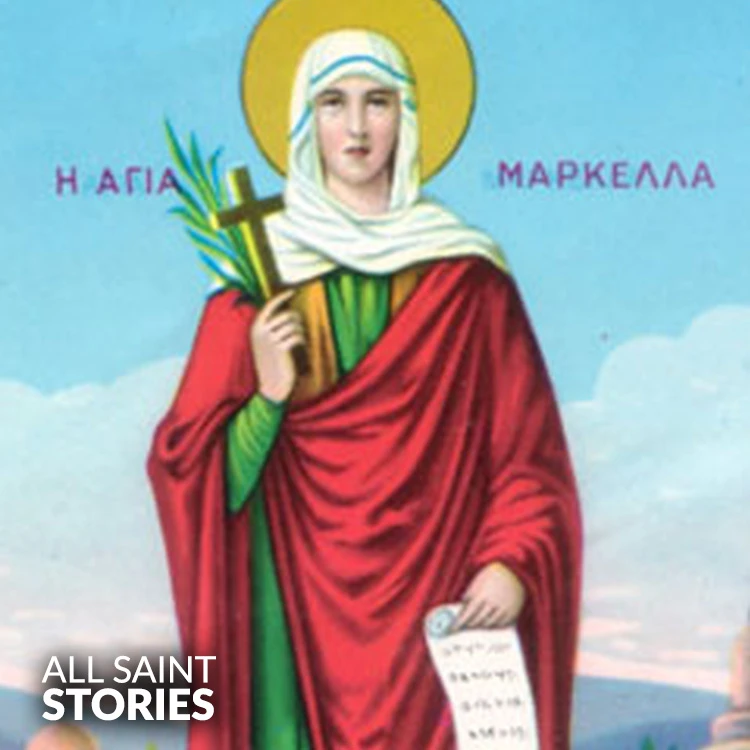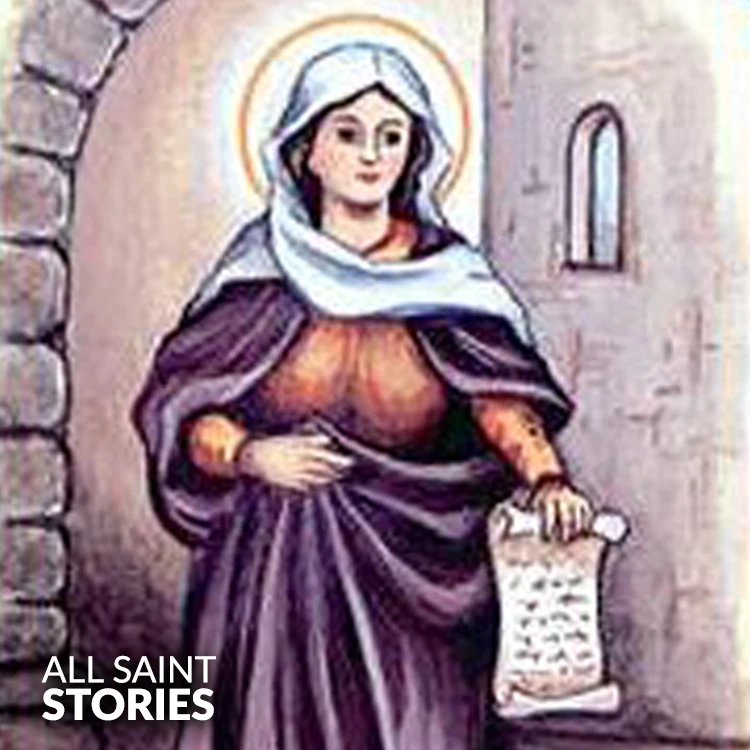Eternal Father, you guided St. Marcella to serve you through a life of prayer, penance, and heartfelt charity. Grant us, by her example, the spirit of humility, detachment from worldly allure, and trust in your unfailing providence. Through her intercession, may we remain faithful in trials, generous in service, and ever focused on the riches of your kingdom. We ask this through Christ our Lord. Amen.
ST. MARCELLA
ST. MARCELLA

St. Marcella of Rome was a wealthy noblewoman who embraced asceticism and devoted herself to prayer, study, and charitable works. Guided by spiritual giants like St. Jerome, she transformed her luxurious mansion into a place of pious gathering and instruction. Her profound faith and dedication to scripture influenced many women of her class to follow a similar path of sanctity. She suffered during the Sack of Rome in 410, succumbing shortly thereafter. Revered for her holiness, wisdom, and compassion, she is remembered on January 31 as an early witness to the power of a life devoted entirely to God.
| St. Marcella was born into a life of privilege in fourth-century Rome, when imperial power still held sway but social and religious transformations were rapidly taking place. Although her exact birth date remains unrecorded, historians place it around the year 325. Raised in a noble family, Marcella was poised to enjoy all the refinements of aristocratic society: luxurious banquets, fine clothing, and a social circle comprised of influential Roman elites. Yet, from an early stage, she showed an inclination toward the deeper dimensions of Christian faith that were gaining prominence in her day. At a time when Christianity had recently been legitimized in the empire, the Church was clarifying its doctrine, celebrating its martyrs, and grappling with widespread conversions from pagan religions. Marcella sensed a calling beyond the boundaries of a conventional patrician life, a yearning to place God at the center of every pursuit. |
Her marriage was short-lived, as she was widowed after mere months. Given that many wealthy widows of Rome remarried for security or social standing, Marcella's decision to remain single was unusual for her station. Instead, she turned her residence on the Aventine Hill into a proto-monastic environment. She received guidance from notable Church figures, most famously St. Jerome, who came to Rome in the 380s. Jerome, already celebrated for his scriptural expertise, encountered in Marcella a devout woman determined to study Scripture in depth. Their intellectual camaraderie grew, as she questioned him eagerly on biblical passages, debated interpretive methods, and shared an ardent wish to integrate Scripture into daily life.
With Jerome’s translations and commentaries in hand, Marcella’s household became a vibrant center of Christian learning. She, along with a circle of like-minded noblewomen, established a routine of prayer, spiritual reading, and charitable service. This environment reflected the spirit of asceticism spreading among the Roman aristocracy, as more converts adopted the ideals of simplicity and detachment once associated primarily with desert hermits in Egypt or the monastic communities in the East. Marcella turned her back on excessive adornments, wearing simpler garments and devoting her financial resources to feeding the poor, caring for widows in worse circumstances, and assisting needy pilgrims. Some historians view her home as a forerunner of Christian communities later formalized into convents. She welcomed visitors—both clerical and lay—who sought a place to discuss theology, share prayer, and receive practical counsel.
She exhibited a keen theological mind and was known to engage St. Jerome in robust conversations that he documented in some of his letters. In these correspondences, he acknowledged Marcella’s grasp of Scripture, praising her for intelligent insight and disciplined questioning. His remarks reveal an atmosphere in which women, often confined to domestic roles, found a forum for spiritual inquiry and an avenue for leadership in piety. Marcella’s letters, though lost, were likely instrumental in shaping the theological discussions among these Roman ascetics, whose influence reached the wider Christian world through Jerome’s prolific writings.
Despite her noble background, Marcella insisted on a regimen of personal discipline. Fasting formed part of her daily routine, as did prayer at set hours. She set aside material wealth in favor of giving alms. This was not a mere performance of charity but a tangible reflection of her interior conviction that spiritual riches surpassed earthly gains. She guided younger women such as Principia, Asella, and Furia, encouraging them to reject frivolous pastimes and instead engage in the study of holy texts and the care of the marginalized. Marcella’s example was so compelling that several of her friends left Rome to pursue monastic vocations in the East, while others chose to remain by her side, establishing a devout Christian community within the city itself.
In addition to her role as a teacher and spiritual mother, Marcella faced theological controversies with courage. The Church was still settling many doctrinal disputes—ranging from Arianism to Pelagianism—and Marcella’s circle often stood at the frontlines of refuting heretical ideas in Rome’s salons. Her close mentorship under Jerome allowed her to clarify the orthodox positions for fellow believers confused by the swirl of debates. When tensions mounted, she leaned on her sharp intellect and unwavering devotion to uphold the faith endorsed by Church councils. This clarity of belief did not express itself in hostility but rather in compassion, seeking to steer errant souls back to truth.
By 410, the city of Rome had become politically vulnerable, its once-imperial strength drained by shifting alliances and economic instability. Alaric the Visigoth led his forces into the city that year, marking a turning point often cited as a harbinger of the Western Roman Empire’s eventual collapse. During this Sack of Rome, violence and chaos reigned for several days. Wealthy homes were looted, and many Romans—noble or poor—fled in terror. Marcella, though advanced in age, did not leave her city. Her household had long been a beacon of charity, so she believed her place was among the suffering. But the invaders, alerted to her noble status, reportedly subjected her to physical abuse in a quest to extract hidden riches. She had devoted so much of her estate to alms and religious activities that almost nothing remained to plunder. Out of frustration, her captors inflicted further cruelty.
Historical sources differ on the exact nature of Marcella’s final hours, but consensus indicates that she survived the initial onslaught only to succumb shortly afterward to the effects of violence, distress, and possibly the heartbreak of seeing her spiritual family scattered. According to some accounts preserved by St. Jerome, she was able to beg mercy for her adoptive daughter Principia before passing away. Even at the end, her concern was to shield those in her care. Her death thus occurred amid widespread devastation, and her body likely did not receive the formal honor that a noblewoman would have enjoyed in more stable times.
Yet, despite these upheavals, Marcella’s legacy endured. Jerome, who had returned to the Holy Land years earlier, wrote in sorrow-laden terms about her fortitude and grace, insisting that her spirit could not be conquered by barbarians. He hailed her as an example of Christian widowhood—combining the virtues of chastity, learning, and compassion. Over time, her memory was woven into the Roman Martyrology, and believers from various parts of the Christian world came to revere her as a saintly widow, a model of ascetic devotion within secular society. The feast day of January 31 commemorates her unwavering pursuit of holiness.
For later generations, Marcella stands as a testament that one need not retreat to the desert to live the evangelical counsels of poverty, chastity, and obedience. She demonstrated that it was possible to cultivate a profound interior life in the heart of a bustling imperial capital. By turning her home into a meeting place for Scripture study, she exemplified the intellectual dimension of faith, proving that devout women could actively shape theological discourse. At the same time, her unwavering commitment to the poor highlighted a radical form of charity that defied the norms of her patrician upbringing. Despite her wealth and social status, she chose a path of simplicity for herself, offering what she had for the relief of others’ suffering.
Marcella’s witness remains relevant. Modern believers invoke her intercession when they seek to deepen their understanding of Scripture, transform their homes into spaces of prayer and hospitality, or dedicate themselves to service despite personal trials. Her life reminds the Church that ascetic practice need not be austere or removed from society—it can bloom amid the everyday challenges of city life. Even in times of societal collapse, Marcella’s faith did not falter. Instead, her final days illuminated how spiritual riches withstand earthly ruin. The countless men and women who later embraced monastic living within or outside urban centers owe a debt to pioneers like her, who dared to let grace flourish wherever God placed them.
Video Not Found
The information on this website is compiled from various trusted sources. While we aim for accuracy, some details may be incomplete or contain discrepancies.
If you notice any errors or have additional information about this saint, please use the form on the left to share your suggestions. Your input helps us improve and maintain reliable content for everyone.
All submissions are reviewed carefully, and your personal details will remain confidential. Thank you for contributing to the accuracy and value of this resource.
Credits & Acknowledgments
- Anudina Visudhar (Malayalam) – Life of Saints for Everyday
by Msgr. Thomas Moothedan, M.A., D.D. - Saint Companions for Each Day
by A. J. M. Mausolfe & J. K. Mausolfe - US Catholic (Faith in Real Life) – Informational articles
- Wikipedia – General reference content and images
- Anastpaul.com – Saint images and reflections
- Pravachaka Sabdam (Malayalam) – Saint-related content and insights
We sincerely thank these authors and platforms for their valuable contributions. If we have unintentionally missed any attribution, please notify us, and we will make the correction promptly.
If you have any suggestion about ST. MARCELLA
Your suggestion will help improve the information about this saint. Your details will not be disclosed anywhere.
© 2025 Copyright @ www.allsaintstories.com


 English
English
 Italian
Italian
 French
French
 Spanish
Spanish
 Malayalam
Malayalam
 Russian
Russian
 Korean
Korean
 Sinhala
Sinhala
 Japanese
Japanese
 Arabic
Arabic
 Portuguese
Portuguese
 Bantu
Bantu
 Greek
Greek
 German
German
 Dutch
Dutch
 Filipino
Filipino